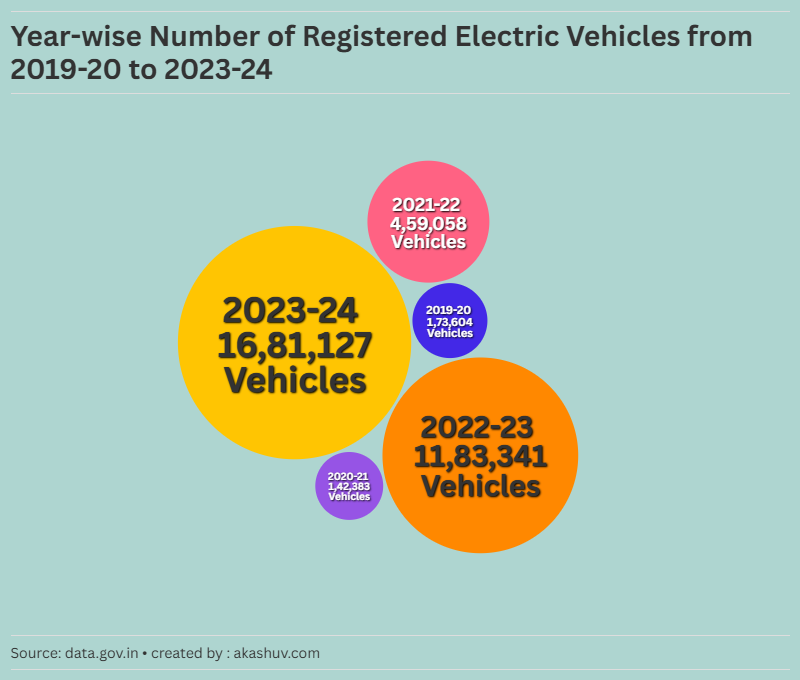Table of Contents
India has embarked on an exciting journey toward greener transportation, and the numbers tell an impressive story. Over the past five years, the adoption of electric vehicles (EVs) has skyrocketed, signaling a significant shift in how Indians perceive sustainable mobility.

Here’s a year-by-year look at the growth in EV registrations:
| Fiscal Year | Registered EVs |
|---|---|
| 2019-20 | 173,604 |
| 2020-21 | 142,383 |
| 2021-22 | 459,058 |
| 2022-23 | 1,183,341 |
| 2023-24 | 1,681,127 |
Source – RAJYA SABHA SESSION – 265 UNSTARRED QUESTION No 1355. ANSWERED ON, 2nd August 2024. Data Figures are in Number.
Dataset URL: https://www.data.gov.in/resource/year-wise-number-registered-electric-vehicles-e-vahan-portal-2019-20-2023-24
What the Numbers Reveal
The data paints an inspiring picture:
- 2019-20 to 2020-21: A Temporary Dip
During the pandemic years, EV registrations saw a slight dip of about 18%, largely due to the economic slowdown and logistical challenges. This was expected as consumer spending shifted to essentials. - 2020-21 to 2021-22: A Triple Leap Forward
As the economy started bouncing back, EV registrations tripled. This marked a turning point, with Indians becoming more receptive to the idea of electric mobility. - 2021-22 to 2022-23: The Big Boom
The following year saw registrations nearly triple again, reflecting heightened awareness, better infrastructure, and improved government incentives. - 2022-23 to 2023-24: Sustained Momentum
The upward trend continued, with a growth rate of over 40% in just one year. It’s clear that EVs are no longer a niche—electric mobility is becoming mainstream.
Why India is Charging Ahead with EVs
Several factors are driving this remarkable growth:
- Government Push
The FAME India Scheme (Faster Adoption and Manufacturing of Hybrid and Electric Vehicles) has been a game-changer. Under FAME II, rolled out in 2019, subsidies and incentives have made EVs more affordable. For instance, as of July 2023, over 832,000 EVs were sold through this scheme, covering two-wheelers, three-wheelers, and four-wheelers. - Improved Charging Infrastructure
Charging anxiety has been a big hurdle for EV adoption, but things are changing. The government has sanctioned nearly 4,500 EV charging stations across cities and highways, making it easier for EV owners to hit the road without worry. - State-Level Support
Many Indian states have introduced their own EV policies. From tax waivers to purchase subsidies, these initiatives are making EVs accessible to a broader audience. - Rising Consumer Awareness
Indians are increasingly prioritizing sustainability and long-term savings. With lower running costs and environmental benefits, EVs are becoming the smarter choice for many families and businesses.
The Road Ahead
The leap from 173,604 EVs in 2019-20 to over 1.6 million in 2023-24 is extraordinary. However, this is just the beginning. With technological advancements, better battery efficiency, and continuous government backing, the EV revolution in India is set to accelerate further.
As consumers, businesses, and policymakers align on the need for sustainable transportation, India could very well become a global leader in the electric mobility sector. The future is electric, and the time to switch gears is now!
Reference: https://pib.gov.in/
Read related blog: Safeguarding the Maritime Nation: Achievements of the Indian Coast Guard
Kerala District wise Per Capita income in 2022-23
- Nuts and Legumes: A Surprising Connection Explained (And Why It Matters to Your Diet)
- Where Do Pine Nuts Originate From? A Journey of Delicious Delicacy
- Discover the 7 Types of Tree Nuts: Unlocking Nutrition and Flavor
- India’s Electric Vehicle Revolution: A 5-Year Growth Story
- Safeguarding the Maritime Nation: Achievements of the Indian Coast Guard

